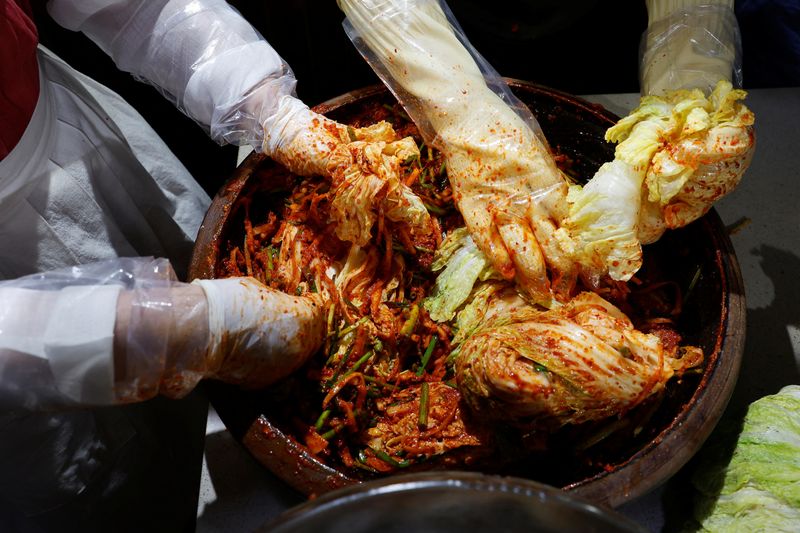By Sebin Choi and Hyun Younger Yi
GANGNEUNG, South Korea (Reuters) – South Korea’s well-known kimchi is falling sufferer to local weather change, with scientists, farmers and producers saying the standard and amount of the napa cabbage that’s pickled to make the ever-present dish is struggling as a result of rising temperatures.
Napa cabbage thrives in cooler climates, and is often planted in mountainous areas the place temperatures throughout the important thing rising summer time season as soon as not often rose above 25 Celsius (77 Fahrenheit).
Research present that hotter climate caused by local weather change is now threatening these crops, a lot in order that South Korea won’t be capable to develop napa cabbage sooner or later as a result of intensifying warmth.
“We hope these predictions don’t come to pass,” plant pathologist and virologist Lee Younger-gyu stated.
“Cabbage likes to grow in cool climate and adapts to a very narrow band of temperatures,” Lee stated. “The optimal temperatures are between 18 and 21 Celsius.”
Within the fields and in kitchens – each business and home – farmers and kimchi makers are already feeling the change.
Spicy, fermented kimchi is constituted of different greens resembling radish, cucumber and inexperienced onion, however the most well-liked dish stays cabbage-based.
Describing the impact of upper temperatures on the vegetable, Lee Ha-yeon, who holds the designation of Kimchi Grasp from the Agriculture Ministry, stated the guts of the cabbage “goes bad, and the root becomes mushy.”
“If this continues, then in the summer time we might have to give up cabbage kimchi,” stated Lee, whose title displays her contribution to meals tradition.
Information from the federal government statistics company reveals the realm of highland cabbage farmed final 12 months was lower than half of what it was 20 years in the past: 3,995 hectares in comparison with 8,796 hectares.
In accordance with the Rural Improvement Administration, a state farming suppose tank, local weather change situations undertaking the farmed space to shrink dramatically within the subsequent 25 years to only 44 hectares, with no cabbage grown within the highlands by 2090.
Researchers cite greater temperatures, unpredictable heavy rains and pests that grow to be tougher to regulate within the hotter and longer summers because the trigger for the crop shrinkage.
A fungal an infection that wilts the plant has additionally been notably troublesome for farmers as a result of it solely turns into obvious very shut to reap.
Local weather change provides to the challenges dealing with South Korea’s kimchi trade, which is already battling lower-priced imports from China, that are principally served in eating places.
Customs knowledge launched on Monday confirmed kimchi imports via the tip of July was up 6.9% at $98.5 million this 12 months, virtually all of it from China and the very best ever for the interval.
Thus far, the federal government has relied on huge climate-controlled storage to stop value spikes and shortages. Scientists are additionally racing to develop crop varieties that may develop in hotter climates and which are extra resilient to giant fluctuations in rainfall and infections.
However farmers like Kim Si-gap, 71, who has labored within the cabbage fields of the japanese area of Gangneung all his life, concern these varieties might be dearer to develop along with not tasting fairly proper.

“When we see the reports that there will come a time in Korea when we can no longer grow cabbage, it was shocking on the one hand and also sad at the same time,” Kim stated.
“Kimchi is something we cannot not have on the table. What are we going to do if this happens?”




